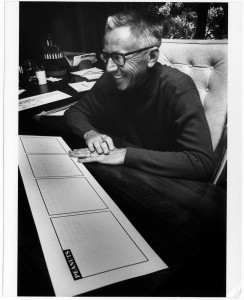Perfection or Calcification?
Wednesday, June 18th, 2014 • Cartoons / Writing
“Peanuts” ran from October 1950 to January 2000—nearly 50 years (“The longest continuous story ever told by a single author”). In all that time, there is not a single strip to which anyone but Charles M. Schulz applied pencil or ink—the only cartoonist ever to earn a million dollars a month was also the only one (amongst the “majors”) never to employ an assistant.
In my opinion the strip reaches its zenith exactly halfway through, in mid-1975. The artwork style and character design stops moving and changing—it’s perfected (or “calcified,” depending on how you look at it). The same is true of the jokes and narrative: essentially, it’s all been done, and he’s starting to repeat himself, moving from trope to trope—baseball field; Red Baron; Schroeder and Beethoven; summer camp; Woodstock’s idiocy; Lucy’s bitching; “Peppermint” Patty in school; etc. all circulate like a Lazy Susan—and the main psychological beats (in particular, Charlie Brown’s incredible existential characterization, which is really the lynchpin of the first two decades) get reduced increasingly to punchlines and takes.
I’m not sure what to make of this. He gets it where he wants it and then stops advancing it—but keeps doing it. The obvious counterexample is “Calvin and Hobbes,” which writer/artist Bill Watterson just ended once he knew he’d played it out (the argument would be reversed if Schulz had stopped in ’75, or if Watterson had kept going up to the present). Time doesn’t move, in the strips, like in a sitcom, and there are no aging actors and contract debates, so Schulz can just keep going forever…and it doesn’t pass to a new generation of artists and writers like Spider-Man, so there are never any “fresh takes” (or “reboots”).
Should he have stopped? There’s nothing wrong with the second half of the run (until he gets arthritis and loses his line, towards the end, which is like Redford losing his face); it’s still “Peanuts,” it’s still funny; it still sits there in the newspaper giving you a moment of Schulz zen (long after the style has become so copied that it’s no longer remotely revolutionary as it was in 1950, when there was absolutely nothing like it anywhere). John Updike kept writing those Rabbit Angstrom novels long after the first one shook up the literary world. I honestly don’t know what the “right move” is or if there is anything like a “right move.”
